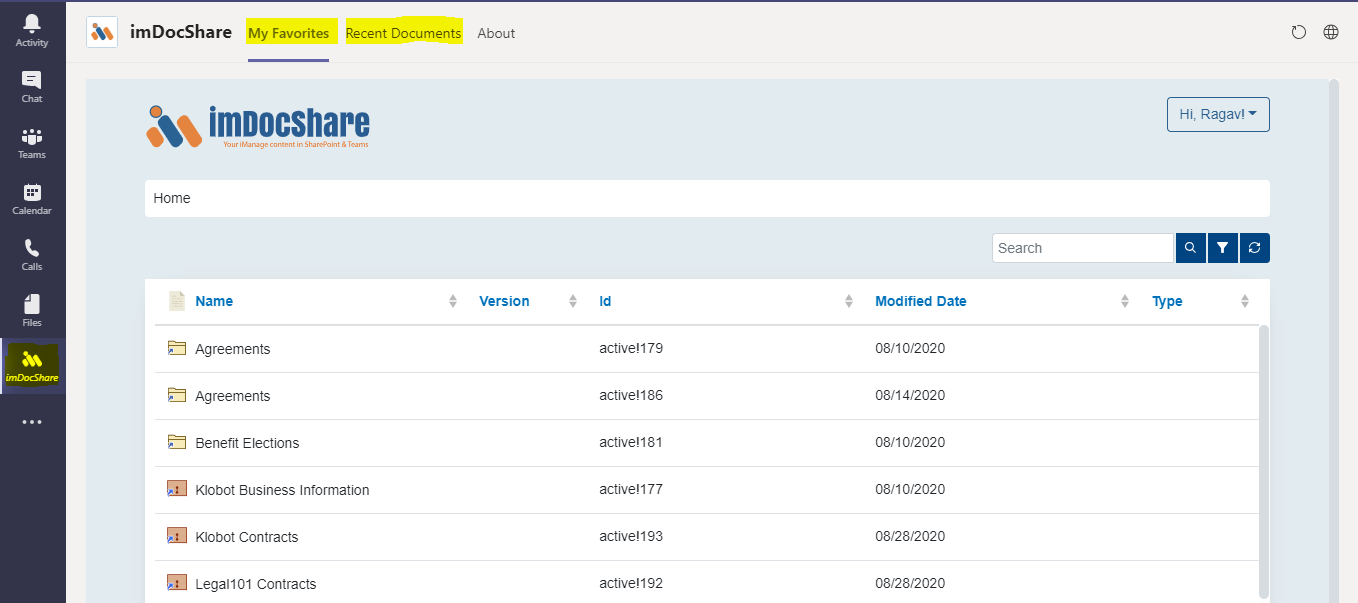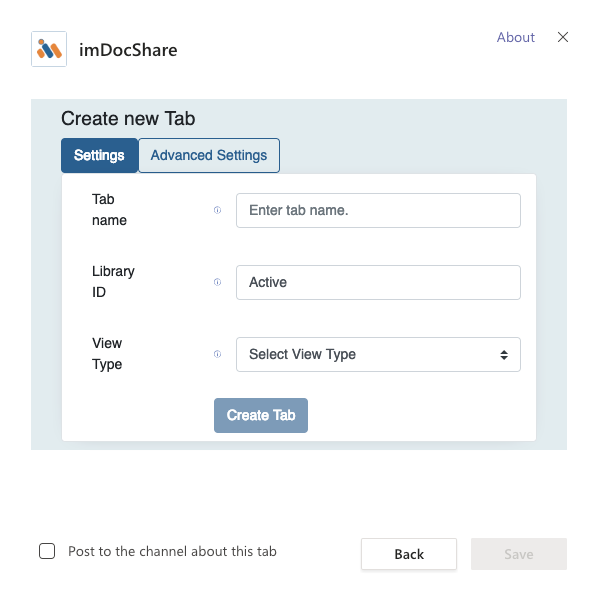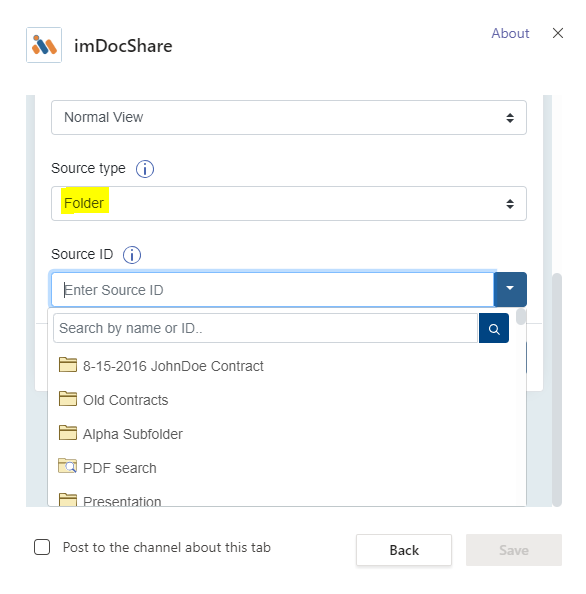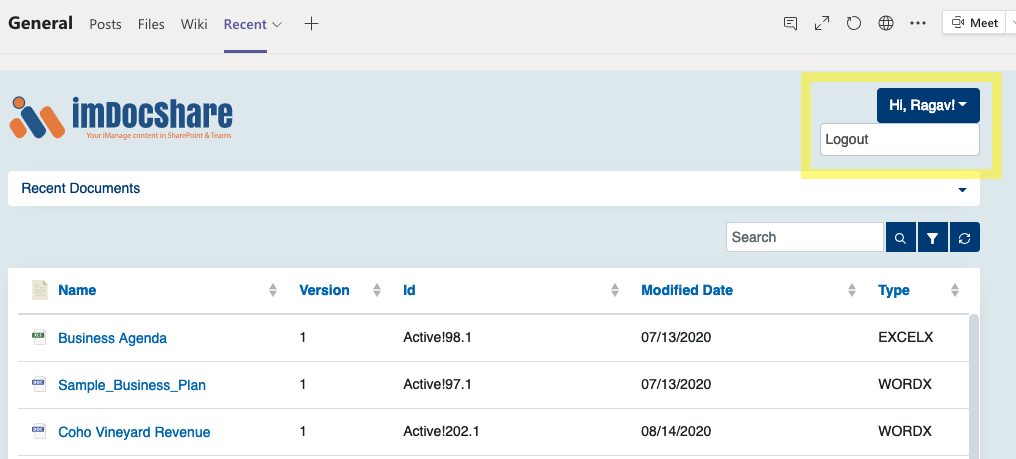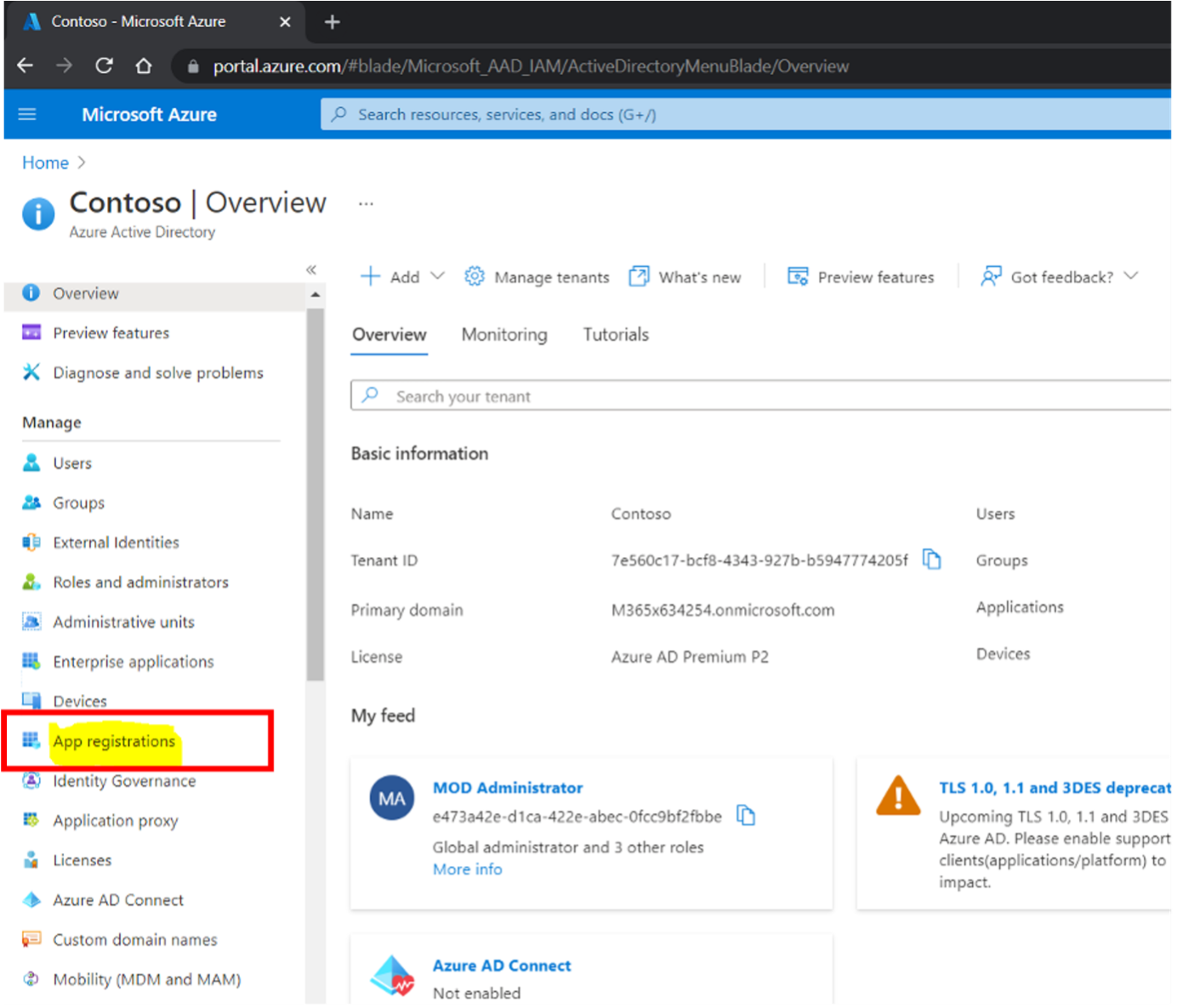Introduction
This guide is a general overview of how to install and configure the Teams App for imDocShare designed for use with the Microsoft Teams desktop application or the Microsoft Teams web app which can be reached at:
This document does not cover any SharePoint-related topics or the in-depth configuration details for imDocShare webparts. This information can be found in the general documentation for imDocShare entitled “imDocShare SPFx webparts Power User Guide” or “imDocShare Visual Webparts for SP2013 On Prem – Power User Guide” depending on which version you have purchased.
The imDocShare Teams App is a powerful application which can use almost all features that are included in our SharePoint implementation. Tab views can be configured and customized in several ways to show the most appropriate documents and containers for a respective user or situation. These Web Parts include:
- imDocShare Document Viewer
- Normal View (show contents of a single container or workspace)
- RecentDocs View (show user’s most recent documents)
- Favorites View (Show user’s favorited documents or containers)
- imDocShare Tree View (Show multiple container sources which can be freely navigated in a tree-style view)
NOTE: Custom App tabs are currently in BETA state for Teams mobile. Any custom App tabs and personal tabs may encounter issues based on mobile device types. Microsoft is aiming to improve this functionality for developers and we will update our application according the documentation link here: https://docs.microsoft.com/en-us/microsoftteams/platform/tabs/design/tabs-mobile. Please look forward to full support in the near future.
Installation
Initial installation is a very quick and easy process. It will be slightly different depending on whether you will be installing from the Microsoft Teams App Store or installing via “side-loading” the app with a standard zip file.
Install from Microsoft Teams Store
Simply search for ‘imDocShare’ in the app search box and select imDocShare to install. The app can be added to a specific Team chat or, in general.
Once install is complete, the following screen which lets users review the privacy and Terms of Usage before adding the app:
Once the app is successfully added, Inside the new team or chat group, click the “+” button on the middle nav bar and this will initiate the new install dialog window. For personal app, simply choose the “Add” option without adding to a specific team or chat group.
Personal App: New Install
If you have installed as a personal app, you will automatically get 2 sample tabs after providing some licensing information. On the welcome screen, you will see that you need to fill in a few parameters:
This is a unique key provided to you by our company when purchasing imDocShare. If you would like to use imDocShare separately, please contact us at [email protected]. More info in the next section. This field will automatically validate the license key and show a warning if an invalid key is detected.
Once you have entered the settings above, the app will require login to iManage continue. Please see the login and authorization section for more info about this. Once authentication has been established, the app will create two default views for you: Recent Documents and My Favorites (highlighted in yellow below). When the app is being used, it will appear on your left-side navigation bar, you may also pin the personal app to your left-side navigation bar by using the “pin” option highlighted in red below:
You will be asked to provide iManage login credentials before any content can be accessed. These Personal Tab views are non-configurable and will always show your personalized content from iManage. If you would like to configure views like this, you may add custom tabs (using “recent” or “favorite” view) in a team or Chat group with customized settings.
Add to Team or Chat group: New Install Dialog
On this screen, you must provide some important details to initialize your application in our service database.
NOTE: This screen will not appear if the personal app install has already been completed. Since your License key has already been registered through the “New personal app” form, instead of this screen, you will directly see the “Create new Tab” screen or authentication screen if required.
Here are the fields that must be filled out in order to begin the process:
This is a unique key provided to you by our company when purchasing imDocShare. If you would like to use imDocShare separately, please contact us at [email protected]. More info in the next section. This field will automatically validate the license key and show a warning if an invalid key is detected.
Once this is complete, you will be asked to authenticate with iManage using the settings you have provided in conjunction with your iManage user credentials.
Once this is complete, you will be ready to create your first tab. Please see the “Creating a new Tab” section for more details.
NOTE: Usage of the “basic” configuration option requires a “masterConfig” to exist. Therefore, the first tab that you create will be very important since it will be used to supplement future ‘basic’ configuration views. If you have installed personal tabs, the masterConfig will default to use the configuration that is used for the “recent Documents’ personal tab. This is a default configuration provided by imDocShare.
imDocShare Licensing
If you are using our SharePoint implementations, you will recognize that imDocShare comes with a unique license ID which will be verified on load. For the Teams App, this license key will only be checked once during initial installation of Personal tabs or Teams tab. Once it has been verified, the Teams App will no longer ask for the license key and instead rely on using your Microsoft Teams Tenant ID to retrieve and persist info in our database.
The service database is only used for the following tasks:
SharePoint Clients
When receiving our imDocShare deployment materials, you should also have received a imDocShareLicenseKey.txt file. This file contains your unique key which will activate imDocShare and the specific features that you have requested. Simply copy the key and use in the “License Key” field. Initial installation cannot move forward without providing this value.
Non-SharePoint Clients
Please visit https://bkg.860.myftpupload.com/product/imDocShare-teams-app-pro to purchase a new subscription.
If you are experiencing any licensing issues, please contact [email protected]
First Time Configuration
As mentioned in the previous section, first time configuration is done by configuring your first tab in the Teams tab implementation OR by completing the Initial install screen for personal tabs. This will create your “Master” config. The “Master” config will be used to supplement future tab configuration editing when using the “basic” or non-advanced editing option. The “Master” configuration cannot be changed so please be careful when adding this for the first time. Note: Personal Tabs cannot be configured. If you would like configurable tabs, you can create them using the view type “Recent Docs” and “Favorite” and configure using the advanced settings editor.
Creating a new Tab view
Completing the “New Install” dialog and authentication will bring you to the “create new tab” screen. Users can continue to create additional tab views by clicking the “+” button found in the middle nav highlighted below:
Select “imDocShare” from the list of apps shown:
This will take you to our “Create new Tab” dialog. Here, you will see two different tabs labeled “Settings” and “Advanced Settings”. These are two alternative ways to create a new tab.
Settings
Give your tab a name that is relevant to the content that will be shown
The source library (formerly called database) which contains your documents. This field will generally be pre-filled with the current user’s ‘preferred library’. This setting can be changed in iManage. You can also change your library ID from this screen. Clicking on the field will open a dropdown menu which contains all libraries which the current user has access to.
Choose a view type. Normal View will display the contents of a single container or sources such as Recent Documents & Favorites. Treeview will allow users to see multiple different sources and navigate between them
Choose the type of container that is being referenced. Multiple sources can be provided for Treeview. Please fill this field before filling the ID to see a dropdown list of all available containers.
Source Identification number for the container which can be found in iManage. Users may manually fill in this field if they know the ID already or a dropdown will provide a list of containers that the current user has access to. Users may also search a container by name or ID. Please see the screenshot below for an example:
*NOTE: Editing a view using the basic “settings” option will revert any config changes that were previously made using the “Advanced Configuration” screen. It will revert your settings to use your “Master” configuration.
Advanced Configuration
Please consult our imDocShare Power User Guide to see more information about configs such as what each property does and what settings can be applied to each property.
*NOTE: Editing a view using the basic “settings” option will revert any config changes that were previously made using the “Advanced Configuration” screen. It will revert your settings to use your “Master” configuration. If you would like to preserve “Advanced” configurations on an individual webpart, please continue editing it using only “Advanced Configuration”.
Edit an existing tab view
Clicking on the arrow button (shown below) beside each tab will show 3 options: settings, rename and delete. Note: Personal Tabs are not configurable. If you would like to configure your “recent” or “favorite” views, please create a team tab with that view and configure as shown below.
Delete will remove the configured tab. This does not delete any content on SharePoint or iManage. It will, however, delete the associated tab information from our service database and you will no longer be able to retrieve the config settings for that tab.
Rename will simply rename the tab that you can see on Teams. This does not edit any names on SharePoint or iManage
Using the “Settings” option will open a dialog that can be used to edit the configuration of your imDocShare tab view. Similar to the “Create new Tab” dialog, there will be 2 main options to change the tab configuration: “Settings” is used for basic configuration and “Advanced Configuration” will use the imDocShare config builder
Clicking the “Advanced Configuration” tab during a tab edit session will automatically import the currently existing settings into the config builder form where you can update them
Makes changes to the settings then click “Update Settings” to validate your current changes. Then you may click “save” in order to see the newly configured view
Please consult our imDocShare Power User Guide to see more information about configs such as what each property does and what settings can be applied to each property.
*NOTE: Editing a view using the basic “settings” option will revert any config changes that were previously made using the “Advanced Configuration” screen. It will revert your settings to use your “Master” configuration. If you would like to preserve “Advanced” configurations on an individual webpart, please continue editing it using only “Advanced Configuration”.
Controlling your iManage Login
As our app is focused on accessing protected content from iManage, login is required before the user can create or edit any views. Immediately after installation and license check, the user will be prompted to login on a screen like below:
Upon clicking the button, users should see a separate popup screen containing the iManage login form.
When viewing tabs that have already been created, users will also be prompted to login if the login session is expired or doesn’t exist.
Each view loaded in imDocShare should come with a “Log out” command that should reset your iManage login session. In our SharePoint environments, showing the logout menu is optional and can be turned on using the Config Builder or by editing the JSON config. In Teams, it is mandatory.
In each view, on the top right corner, you should be able to see a message stating “Hi (your username)”. Clicking on this will open a menu that will provide the option to “Log out” of your current iManage account and refresh the view automatically. Once refreshed, you should be prompted to re-login to iManage using your preferred account name and password. This session will be saved until you execute the logout command again. iManage login is required to view contents in any view.
Un-installing
The imDocShare Teams app is an application that can be installed to a user’s specific Teams application for “Personal” tabs or to specific Teams or group chat instances. A user with administrative privileges over the organization is also able to install the app across the tenant for everyone’s usage. There are 3 methods of un-install:
In order to fully uninstall imDocShare, please follow the procedure below:
Specific Team/Chat Group
Personal / Admin
Troubleshooting and FAQs
Install / Uninstall
In order to resolve any issues regarding install / uninstall, we recommend exiting teams and restarting it again. This tends to resolve many of the most common issues in which Teams does not properly update whether the app exists or not. If the issue persists after several restarts, please contact support at [email protected]
Known Issues
The Teams App includes almost all functionalities that are available in the SharePoint and Web App versions. However, there are small differences and restrictions due to the limitations of the technology. These differences are listed below.
Azure application creating for Teams
Teams Client ID and Secret ID Generation
Step 2: Please click the “Azure Active Directory
Step 3: Once Azure Active Directory is opened, click “App registrations”
Step 4: Then click “New registration”
Step 5: Enter the name for the application and then click Register
Step 6: Go to “API permissions” on the left navigation and click on “Microsoft Graph” to open and update Request API permissions
Step 7: Select and update the following API / permissions names for Microsoft Graph:
Then click, Grant admin consent for [Tenant Name]
- Read.All
- ReadWrite.All
- Read.All
- ReadWrite.All
- Read
- Read.All
- ReadWrite.All
- ReadWrite.All
- Read.All
Step 8: Go to “Certificates and secrets” on the left Navigation and click New client secret. Enter Description, Expiration and then Add.
IMPORTANT:
After adding new client secret, save both the Value and Secret ID generated. This is your only chance to save the value and is needed to connect OneDrive.
Step 9: Go to “Overview” in left navigation, make a note of your Client and Tenant ID
Step 10: Now you have the Client ID, Secret ID, Tenant ID generated and ready. This last step shows the User how to use the values to connect.
Open the netDocShare Sync Admin application, navigate to Microsoft Teams and Add a connection
Teams Tenant – Enter a name you would like to use
Tenant ID – Enter the Directory (tenant) ID noted from the previous step
Client ID – Enter the Application (client) ID noted from the previous step
Client Secret – Enter the Value generated from step 8 after adding new client secret





